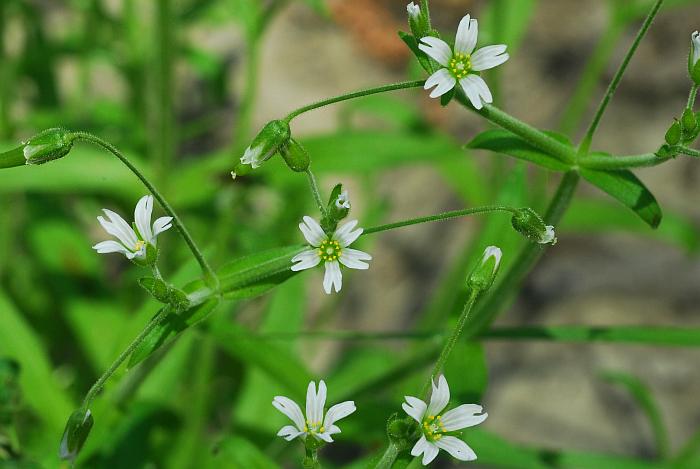Cerastium nutans Raf.
Nodding Chickweed

Native
CC = 2
CW = 3
MOC = 60
© SRTurner
Cerastium nutans Raf.Nodding Chickweed | |
 |
Native CC = 2 CW = 3 MOC = 60 |
© SRTurner |
|
Family - Caryophyllaceae Habit - Annual forb. Stem - Ascending to erect, to 60 cm, sometimes branched near base, densely pubescent with short glandular hairs.
Leaves - Opposite, simple, entire, mostly sessile, 0.5-8.0 cm long, spatulate (some basal leaves) or oblong-lanceolate to narrowly obovate, sharply pointed, pubescent with glandular and nonglandular hairs.
Inflorescence - Loose, open panicles. Bracts entirely green and herbaceous. Flower stalks 1.5-2.7 cm long, 2-5 times as long as sepals, ascending, hooked at tips at fruiting, densely pubescent with glandular hairs.
Flowers - Sepals 5, 2.5-5.5 mm long, lanceolate, green but with membranous margins, pubescent with glandular hairs, these short and not extending beyond sepal tips. Petals 5, 5-7 mm long, 1.0-1.5 times as long as sepals, shallowly 2-lobed at tips (about 1/3 of total length), white. Stamens 10. Styles 5.
Fruit - Cylindrical capsules 8-13 mm long, 2-3 times as long as sepals, curved, brown at maturity, dehiscing via 10 apical teeth. Seeds 0.5-0.8 mm wide, the surface tuberculate, yellowish brown.
Flowering - March - June. Habitat - Streambanks, bluffs, forests, fields, open disturbed areas. Origin - Native to the U.S. Lookalikes - Several other species of Cerastium, and to a lesser extent, Stellaria. Differentiation requires attention to fine details, including fruit shape and number of styles. Other info. - This is one of only two small-flowered species of Cerastium which are native to Missouri. It is common throughout the state. Its distribution across the continent is somewhat spotty, though it is found in most states and also Canada. The small-flowered Cerastiums can be a bit challenging to identify, but this one is fairly distinctive with maturing flowers and fruits borne on long stalks which are hooked near the tips. Under favorable conditions the plants can get rather large. Photographs taken at Columbia Bottoms Conservation Area, St. Charles County, MO, 4-24-2016 (SRTurner). |